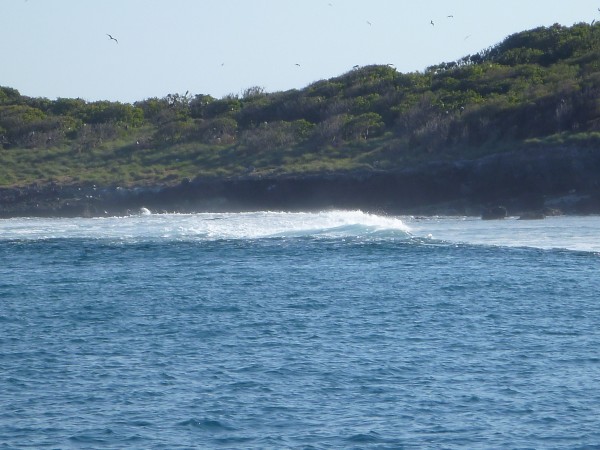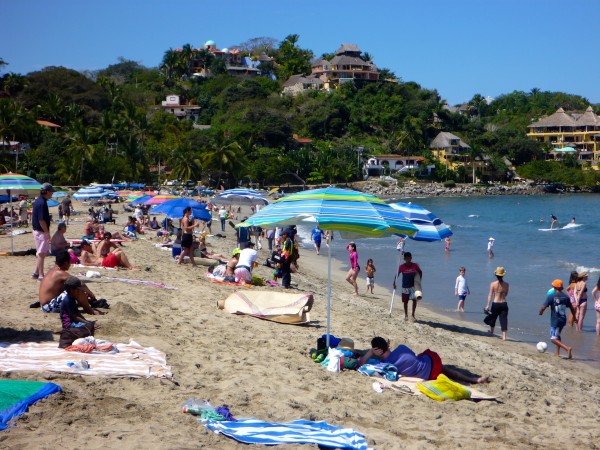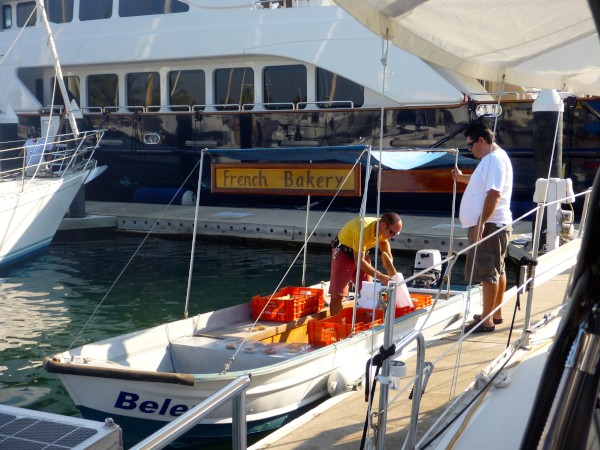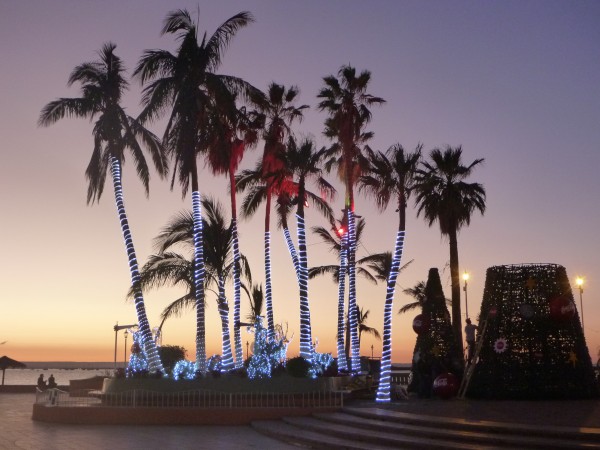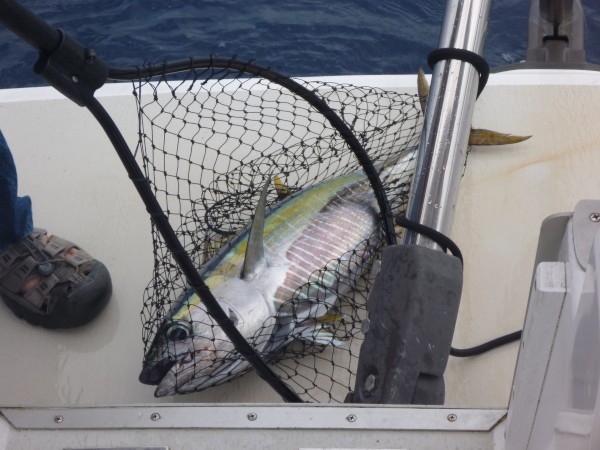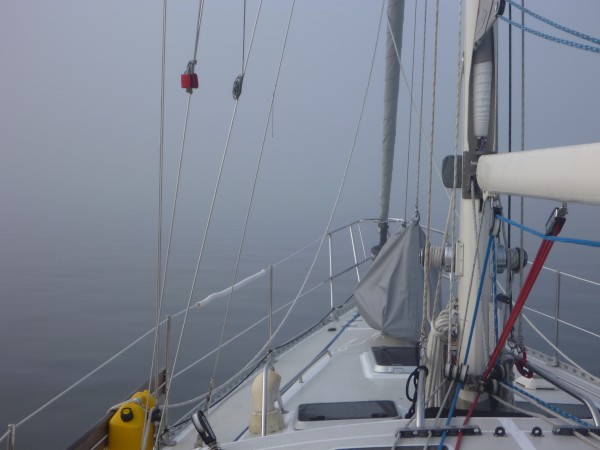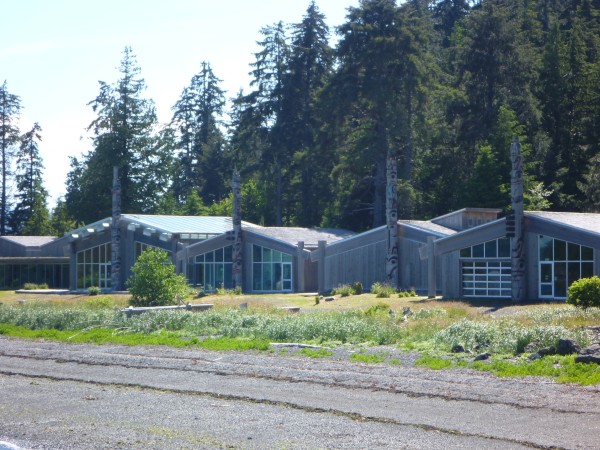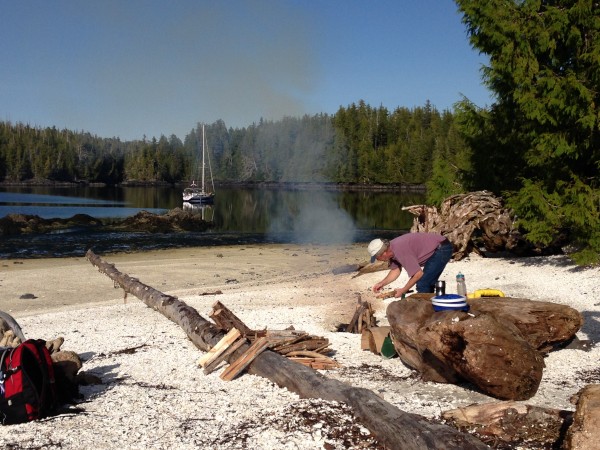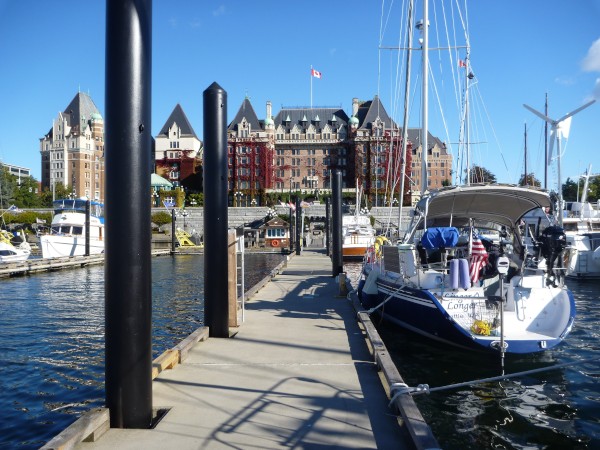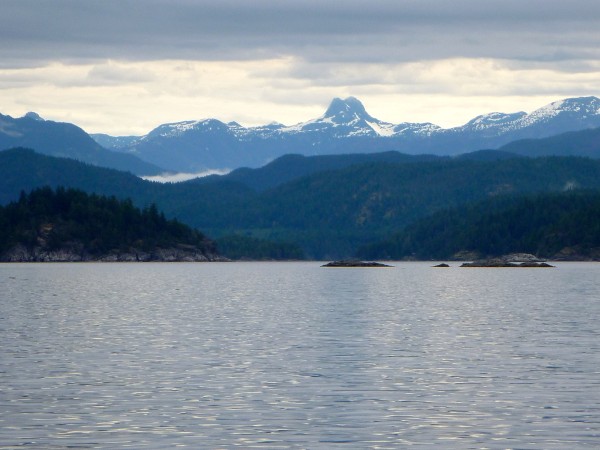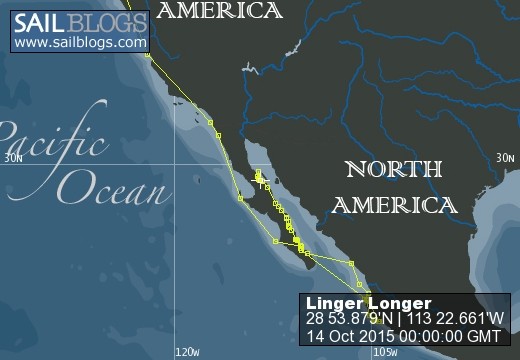
Linger Longer
14 September 2016
06 August 2016
09 July 2016
19 March 2016
19 December 2015
18 December 2015
18 December 2015
03 November 2015
18 July 2015
24 May 2015
04 April 2015
31 March 2015
26 February 2015
15 February 2015 | Barra de Navidad
07 February 2015 | Tenacatita Bay
04 February 2015
26 January 2015 | 19 18.051'N
04 January 2015 | La Cruz, Nayarit, Mexico
25 December 2014 | La Paz, Baja California Sur, Mexico
01 December 2014 | Ensenada, Mexico
Reflections by Kirk
06 August 2016
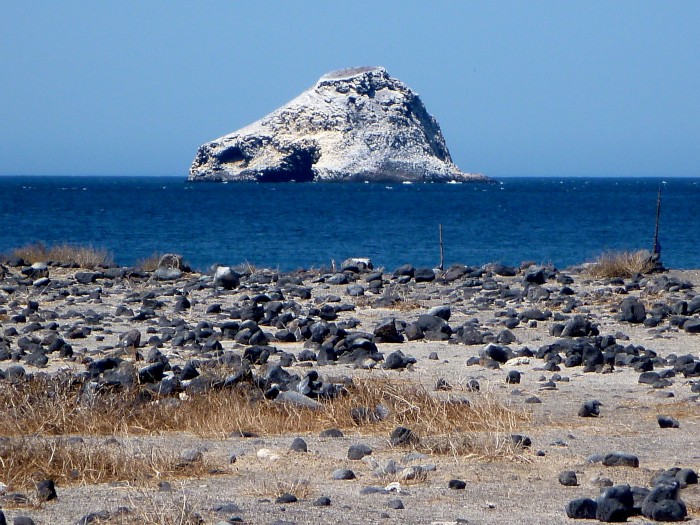
Photo: Roca Blanca at Isla Partida in the Midriff Islands, Sea of Cortez
Living on our boat is a bit different than life in our old house on Novelty Hill road in Redmond, Washington. For one, our current home is very mobile. When we want a change of scenery, we pick up the anchor or remove the dock lines and go to some other place. There are basically two types of places where we live - one is tied to a dock and the other at anchor. Even though it is all living in a boat, these two different types of places involve some different living circumstances. Tied to a dock, we get on and off the boat more. There is usually a town or village nearby where we go to shop, eat out, listen to live music, do laundry, typical land living kind of stuff. We tend to spend more money, not just on marina fees, but because there are so many places where you can go and spend money eating out, buying boat stuff, a new tee shirt or just sitting under a thatch roof with a bucket of iced beer. This may not be such a bad thing down here in sunny Mexico, as it is currently a very cost-effective place to live. There are normally many other boats in the marina; and in short order, you at least get familiar with the people on your own dock as everybody walks to and fro their boats. To socialize, we just walk to another boat or they walk to ours. The towns or villages are where we get to mix with the local population and experience a little more of Mexican culture. We get a chance to catch up on boat projects, which is much easier when you are in proximity to places that sell boat parts or hardware stores where you can figure out how to fabricate what you need (maybe). Marinas, in general, offer more security from the effects of nasty weather. These are all good things, except for the higher spending, but we almost always long to get away from the dock and back to life at anchor.
There are some hybrid spots where you can choose to be in a marina or anchor out. Down here, in Mexico, there are few places where we have that option. La Paz, La Cruz in Banderas Bay, and Barra Navidad are the only ones that readily come to mind. The three places mentioned tend to have a large number of boats in the anchorage. Most of the time in these places we choose to be in the marina. This is due mainly to the convenience of being able to walk to the places we want to go rather than hopping in the dingy, finding a safe place to tie it up and hauling all of the shopped for goods back to the boat in the dingy or trying to find our boat amongst a sea of anchor lights after a night of dinner and beverages. We are also more reluctant to swim from the boat in places where we are uncertain about the waste handling practices of the towns and villages as well as large numbers of other boaters. When we are safely tied to the dock during bigger wind events, it is not uncommon to hear VHF radio reports of boats that are freely wandering around the anchorage as the anchoring system has suffered some type of failure. We have been in a few anchorages where boats are "dragging anchor." This can be a bit disconcerting when the boat in question is unattended and heading in our direction.
Our preference is to be in a beautiful anchorage with a minimum of other boats, that offers nice protection from wind and waves. Sometimes this can be a challenge. Anchorages that are both beautiful and offer good protection tend to be sought after, so the minimum boat thing does not happen that often during the "high" season. We now find ourselves in the hot summer "low" season in the northern portion of the Sea of Cortez. Wonderful options for anchoring in beautiful uncrowded places abound. It is not always a bowl of cherries but often more like Forrest Gump's box of chocolates. You sometimes do not know what you are going to get. The main problems are the big uncomfortable wind events that are difficult to forecast and always happen in the middle of the night. Not talking about hurricanes which tend to have reasonably reliable forecasts, but chubascos (thunderstorms), elephantes (big hot winds that roll down the mountains from the west) or cormuels (big southerly winds that happen mostly in the La Paz area). Thunderstorms are what I am the most concerned with. Growing up in New Jersey, I am quite familiar with these storms and used to love experiencing them from the safety of a porch. We would see the dark clouds approach, and then the thunder starts off in the distance. Count one thousand one, one thousand two, etcetera to determine how far away the lightning that generates the thunder is. About five seconds equals one mile. As the lightning got closer, the wind and rain would start; and then before you know it, the whole thing is right overhead with flashing and crashing and rain blowing sideways. It really was exciting. When a tree got hit, the boom was especially loud with a different pitch. If the hit tree were to fall across power lines, the excitement just intensified. I now feel differently about thunderstorms. Sailboats have these very tall aluminum sticks called masts. Our mast, aka lightning rod, goes right through the living room (salon). This is cause for concern. Lightning is a poorly understood phenomena, but we are certain that should it strike our mast not much good would result. Lightning strikes are the primary concern. Next are the violent winds that can accompany these storms. It is usually strong with stronger gusts. We have been through a number of these. The noise of wind in the rigging can be almost frightening, like a high-pitched squeal. The strong winds will move the boat around and gusts can send it leaning (heeling is the sailing term) from one side to the other. Strong winds can create a very uncomfortable chop in the water, making the boat bounce up and down and from side to side in addition to the wind effects. These are usually short lived; but as I said, usually happen in the middle of the night. It seems to take us a minimum of one and a half hours from the time we are so rudely awakened, until we put the head back on a pillow. We have only experienced chubascos with winds into the mid-thirties, but know of several people who have experienced winds above fifty knots. Hope to avoid such high winds, but the longer we stay in tropical climes the more chance that we too will experience unmitigated terror. Maybe a little terror now and then will give me a heightened appreciation for other, better things. The other thing that can make anchoring out more of an unpleasant exercise is when we get into a situation where the boat is pointed in one direction, but the waves come from 90 degrees to that direction. This means that the boat rolls from side to side. It can roll 20 degrees from vertical, one side, to 20 degrees from vertical on the other side in a matter of seconds. Pots, pans and dishes rattle, drawers can become unlatched and take flight. Things start sliding around on what used to be a flat horizontal surface. Watching a bowl of soup slide to the edge of the table and then fall over the side is not fun, but may still be worth a few laughs at a later date. These are extreme happenings and not the norm of our life at anchor. There is a much better side that keeps us coming back to the desire to be "on the hook." Most times the boat will have a very gentle rocking motion. It does not really have an impact on what we do other than going to bed at night. The gentle rocking makes me think of a baby in a cradle or with head on a mother's shoulder as she rocks back and forth while making soothing noises. We even get the soothing noises with small wavelets kind of singing as they strike the boat sides.
There is usually much more privacy while at anchor. It is unusual to have another boat within 100 yards of us and sometimes the nearest living soul is miles away. Having a beautiful and protected anchorage all to ourselves is just as good as it gets. We can play music as loud as we like. Wardrobe selections can be as weird as we like. We can go skinny-dipping. We can just sit and contemplate the state of the universe without any distractions other than those created by Momma Nature. There are a bunch of reasons that we like to be at anchor, but I will try to just highlight a few of the natural things that make big impressions on me. Things that can best be appreciated from a boat at anchor.
First thing, about which I have written previously, is the nighttime light show. For me it starts with bioluminescence. I do not know the science of this, but there seem to be gazillions of really tiny organisms that glow in the water after dark. I suspect that they also glow during the day, but we cannot see them. So looking down into the water, once your eyes have become adjusted to the dark, it looks as though you are looking at a three dimensional starscape, only the "stars" are kind of a fluorescent green and in constant motion. There are several variations to this magical phenomenon. Anything that moves, like fish, will create the glow. We have small solar powered LED lights spaced around the boat. They have a photo sensor and come on when it gets dark. These lights, although not terribly bright, attract crowds of small fish. As these fish swim around, each one leaves it's own little trail of glow, so we have a swirling mass of magic light. As is the way of the world, big fish eat small fish, so once in awhile, a big glowing streak will zoom through the swirling mass and all the little ones scatter. Very trippy. Sometimes a blob of glow just appears on the surface and then expands and spreads out almost like an oil slick. The oil slick blobs tend to happen only for a short time in the early darkness within maybe two to three hours of sunset. Porpoises, rays and sea lions also add to the show. Rays, who will be discussed in more detail a little later, sometimes fly out of the water. They tend to land with a big splash that makes a large and very bright glow. When porpoises are nearby, we have seen a plume of glow rise from the water when they come up to take a breath. Sea lions are cool just because they are so big and can make a huge trail of glow when they swim about. We have just recently seen a new facet to the magical glow. During two recent chubasco events, of course in the middle of the night, the water was alive with the glow. As the wind increased many thousands of small fish started swimming in large schools right at the surface. You may have noticed at some time or another that when a gust of wind blows over water the resultant ripples look like a section of darker water that moves along with the gust. Well, during the windy part of the recent chubascos, these schools of small fish made for a similar visual effect. Huge sections of water just glowed and moved about. This activity attracted the sea lions and diving birds. Yes, even birds were working in the wee hours. The diving birds made a bright splash glow. The sea lions were even better. We could track them by the glow. A large bright spot would appear maybe 20 or 30 yards from the schooling fish and then take off like a torpedo right into the middle of this mass of fish, making them disperse into every direction. A few times an especially bright lightning flash would also make the whole school scatter. The unusual bioluminescence show along with flashes of lightning from almost all directions made for a visual cornucopia not to be soon forgotten. I would estimate that, up here in the Sea of Cortez, we see lightning flashes five nights out of seven. Most of this lightning is 60 or more miles away up in the mainland mountains on the other side of the Sea. We have become more adept at judging how far away they are, how fast they may be moving, and whether or not they may expand out into the Sea and come all the way over to us on the west side. These flashes add to the plethora of nightly light show effects. The last part of the nocturnal nuance is the sky itself. When out at anchor we are usually unaffected by "light pollution" of city lights and the sky is filled with uncountable numbers of twittering specs of light. There is a man who frequently joins the morning radio net, who will give us a heads up for overhead passes of the International Space Station, predicted meteor showers, unusual alignment of planets and so forth. I end up much preferring new moon nights to full moon nights, as the moonlight does not wash out all of the spectacular nighttime lights. No matter where you look, up, down or straight out at the horizon something of visual appeal awaits.
One of the other very intriguing natural events to witness from an anchored boat is the show that rays can produce. By rays, I mean the sea creatures that have a diamond kind of shape with "wings" and a long skinny "tail." Most would be familiar maybe with manta rays, but those guys are huge and that is not what we have seen. We believe that we are mostly seeing Mobula rays. As I mentioned earlier, rays jump out of the water. I have been told that this behavior is to loosen krill from there bodies that they then turn around and consume. I think it is also possible that they are just having fun. Often we will see a solitary ray having its own little jump fest. It will make a run of one to five or more jumps and then we may not see it again. Other times there will be prolonged sets of jumps. What is most spectacular is when a whole school of rays start jumping. Sometimes we get a hint of the upcoming show. Rays gliding near the surface show "wing" tips, two triangles out of the water, moving in tandem for each ray. At times we guess that we see a hundred or more of these "wing" tips, meaning that many rays are traveling in a school near the surface. One will jump out of the water, sometimes just two airborne flaps of the wings and then a perfect belly flop. The sound is almost like a firecracker. Sometimes they will spin one half or one full or one and a half flips before landing back in the water. After the first one jumps another will follow and the whole thing just accelerates until there is always at least one ray in the air. Sometimes five or more will be airborne at the same time. This can go on for maybe ten minutes, sometimes less, sometimes more. The resultant sound is like a whole giant string of firecrackers going off. Just recently we had a school on one side of the boat and another on the other side. It was like firecrackers in stereo.
Diving birds are another one of our favorite things to watch. By diving birds, I refer to birds that dive from a height, into the water. You can see this from shore as well as from a boat, but the boat allows us to visit offshore islands or big rocks that tend to attract a larger quantity as well as a larger variety of diving birds. As it is difficult for threatening predators to access these places, bird populations soar. Mexican nautical charts are filled with places called Roca Blanca. This translates to white rock. The white comes from countless generations of bird guano. Pelicans are probably the most familiar diving bird. These birds are ungainly as they sit in the water, a drab gray, with a head and beak combination that looks like a mistake. We found a pelican head and beak skull on a beach that measures seventeen inches long. When they fly everything changes. With large wings they can skim just above the water and not flap a wing, then head up and circle around searching for prey. They are really beautiful in flight. When several pelicans are flying together, we call it "the squadron." "Follow the leader" is fun to watch. If the lead bird changes direction, whether up, down, left or right, all of the following birds will make the same move in the same location as the lead bird. They also fly in a V-formation that reminds me of the Blue Angels performing in the skies over Lake Washington in Seattle. While single birds are hunting and circling about, flight will hesitate and then they plunge nearly vertical, head first into the water to catch a fish. If they are successful, a large pouch will drop down from the huge beak full of water and fish. They shake the head a little and then tilt back and swallow. There are times when the baitfish are so plentiful that the pelicans do not even bother to get some altitude and circle around. They get maybe a few feet above the water and make a near horizontal entry. They are fun to watch. My current favorite diving bird is the Boobie. Most of the Boobies we see are of the blue-footed variety. Their diving style is a bit different than pelicans. Boobies fly much higher up than pelicans, maybe as high as one hundred feet in the air. They also circle around looking for fish and have the same little hesitation before plunging headfirst like a bullet into the sea. The difference is the speed at which they hit the water and the cleanliness of the entry. If you have ever watched diving during the Summer Olympics, you hear the announcers commenting on the entry. The perfect entry has almost no splash and makes a "poosh" noise rather than a splash noise. Boobies are like that. They enter the water with little splash, but make a little more noise than the Olympians. They sometimes fish near the boat and we can see the trail of bubbles go quite deep, so I guess that they can target different fish than the pelicans. We also have the beak skeleton of a Boobie and it comes to a point so sharp that it could be used as an awl to poke holes in leather. In anchorages near shore we see maybe ten boobies at a time working the water. At offshore islands and near Roca Blancas we may see 100 boobies working alongside the pelicans. When there is a big school of baitfish, it can almost sound like machine gunfire as dozens of birds at once plunge into the sea: splash, splash, (pelicans), poosh, poosh, poosh, (boobies) and so on.
And then there are the flying fish. They exit the water, glide just above the wave tops for 100 feet or more and then back into the water. How and why do they take flight? Once I learn more, I may address this in the future.
Well, life is still peachy keen aboard the good ship "Linger Longer." Water is warm and clean. The fishing is plentiful. The camaraderie amongst the small number of boats spending the summer up here continues to grow.
Hope all is well where you are.
Kirk
S/V Linger Longer
Living on our boat is a bit different than life in our old house on Novelty Hill road in Redmond, Washington. For one, our current home is very mobile. When we want a change of scenery, we pick up the anchor or remove the dock lines and go to some other place. There are basically two types of places where we live - one is tied to a dock and the other at anchor. Even though it is all living in a boat, these two different types of places involve some different living circumstances. Tied to a dock, we get on and off the boat more. There is usually a town or village nearby where we go to shop, eat out, listen to live music, do laundry, typical land living kind of stuff. We tend to spend more money, not just on marina fees, but because there are so many places where you can go and spend money eating out, buying boat stuff, a new tee shirt or just sitting under a thatch roof with a bucket of iced beer. This may not be such a bad thing down here in sunny Mexico, as it is currently a very cost-effective place to live. There are normally many other boats in the marina; and in short order, you at least get familiar with the people on your own dock as everybody walks to and fro their boats. To socialize, we just walk to another boat or they walk to ours. The towns or villages are where we get to mix with the local population and experience a little more of Mexican culture. We get a chance to catch up on boat projects, which is much easier when you are in proximity to places that sell boat parts or hardware stores where you can figure out how to fabricate what you need (maybe). Marinas, in general, offer more security from the effects of nasty weather. These are all good things, except for the higher spending, but we almost always long to get away from the dock and back to life at anchor.
There are some hybrid spots where you can choose to be in a marina or anchor out. Down here, in Mexico, there are few places where we have that option. La Paz, La Cruz in Banderas Bay, and Barra Navidad are the only ones that readily come to mind. The three places mentioned tend to have a large number of boats in the anchorage. Most of the time in these places we choose to be in the marina. This is due mainly to the convenience of being able to walk to the places we want to go rather than hopping in the dingy, finding a safe place to tie it up and hauling all of the shopped for goods back to the boat in the dingy or trying to find our boat amongst a sea of anchor lights after a night of dinner and beverages. We are also more reluctant to swim from the boat in places where we are uncertain about the waste handling practices of the towns and villages as well as large numbers of other boaters. When we are safely tied to the dock during bigger wind events, it is not uncommon to hear VHF radio reports of boats that are freely wandering around the anchorage as the anchoring system has suffered some type of failure. We have been in a few anchorages where boats are "dragging anchor." This can be a bit disconcerting when the boat in question is unattended and heading in our direction.
Our preference is to be in a beautiful anchorage with a minimum of other boats, that offers nice protection from wind and waves. Sometimes this can be a challenge. Anchorages that are both beautiful and offer good protection tend to be sought after, so the minimum boat thing does not happen that often during the "high" season. We now find ourselves in the hot summer "low" season in the northern portion of the Sea of Cortez. Wonderful options for anchoring in beautiful uncrowded places abound. It is not always a bowl of cherries but often more like Forrest Gump's box of chocolates. You sometimes do not know what you are going to get. The main problems are the big uncomfortable wind events that are difficult to forecast and always happen in the middle of the night. Not talking about hurricanes which tend to have reasonably reliable forecasts, but chubascos (thunderstorms), elephantes (big hot winds that roll down the mountains from the west) or cormuels (big southerly winds that happen mostly in the La Paz area). Thunderstorms are what I am the most concerned with. Growing up in New Jersey, I am quite familiar with these storms and used to love experiencing them from the safety of a porch. We would see the dark clouds approach, and then the thunder starts off in the distance. Count one thousand one, one thousand two, etcetera to determine how far away the lightning that generates the thunder is. About five seconds equals one mile. As the lightning got closer, the wind and rain would start; and then before you know it, the whole thing is right overhead with flashing and crashing and rain blowing sideways. It really was exciting. When a tree got hit, the boom was especially loud with a different pitch. If the hit tree were to fall across power lines, the excitement just intensified. I now feel differently about thunderstorms. Sailboats have these very tall aluminum sticks called masts. Our mast, aka lightning rod, goes right through the living room (salon). This is cause for concern. Lightning is a poorly understood phenomena, but we are certain that should it strike our mast not much good would result. Lightning strikes are the primary concern. Next are the violent winds that can accompany these storms. It is usually strong with stronger gusts. We have been through a number of these. The noise of wind in the rigging can be almost frightening, like a high-pitched squeal. The strong winds will move the boat around and gusts can send it leaning (heeling is the sailing term) from one side to the other. Strong winds can create a very uncomfortable chop in the water, making the boat bounce up and down and from side to side in addition to the wind effects. These are usually short lived; but as I said, usually happen in the middle of the night. It seems to take us a minimum of one and a half hours from the time we are so rudely awakened, until we put the head back on a pillow. We have only experienced chubascos with winds into the mid-thirties, but know of several people who have experienced winds above fifty knots. Hope to avoid such high winds, but the longer we stay in tropical climes the more chance that we too will experience unmitigated terror. Maybe a little terror now and then will give me a heightened appreciation for other, better things. The other thing that can make anchoring out more of an unpleasant exercise is when we get into a situation where the boat is pointed in one direction, but the waves come from 90 degrees to that direction. This means that the boat rolls from side to side. It can roll 20 degrees from vertical, one side, to 20 degrees from vertical on the other side in a matter of seconds. Pots, pans and dishes rattle, drawers can become unlatched and take flight. Things start sliding around on what used to be a flat horizontal surface. Watching a bowl of soup slide to the edge of the table and then fall over the side is not fun, but may still be worth a few laughs at a later date. These are extreme happenings and not the norm of our life at anchor. There is a much better side that keeps us coming back to the desire to be "on the hook." Most times the boat will have a very gentle rocking motion. It does not really have an impact on what we do other than going to bed at night. The gentle rocking makes me think of a baby in a cradle or with head on a mother's shoulder as she rocks back and forth while making soothing noises. We even get the soothing noises with small wavelets kind of singing as they strike the boat sides.
There is usually much more privacy while at anchor. It is unusual to have another boat within 100 yards of us and sometimes the nearest living soul is miles away. Having a beautiful and protected anchorage all to ourselves is just as good as it gets. We can play music as loud as we like. Wardrobe selections can be as weird as we like. We can go skinny-dipping. We can just sit and contemplate the state of the universe without any distractions other than those created by Momma Nature. There are a bunch of reasons that we like to be at anchor, but I will try to just highlight a few of the natural things that make big impressions on me. Things that can best be appreciated from a boat at anchor.
First thing, about which I have written previously, is the nighttime light show. For me it starts with bioluminescence. I do not know the science of this, but there seem to be gazillions of really tiny organisms that glow in the water after dark. I suspect that they also glow during the day, but we cannot see them. So looking down into the water, once your eyes have become adjusted to the dark, it looks as though you are looking at a three dimensional starscape, only the "stars" are kind of a fluorescent green and in constant motion. There are several variations to this magical phenomenon. Anything that moves, like fish, will create the glow. We have small solar powered LED lights spaced around the boat. They have a photo sensor and come on when it gets dark. These lights, although not terribly bright, attract crowds of small fish. As these fish swim around, each one leaves it's own little trail of glow, so we have a swirling mass of magic light. As is the way of the world, big fish eat small fish, so once in awhile, a big glowing streak will zoom through the swirling mass and all the little ones scatter. Very trippy. Sometimes a blob of glow just appears on the surface and then expands and spreads out almost like an oil slick. The oil slick blobs tend to happen only for a short time in the early darkness within maybe two to three hours of sunset. Porpoises, rays and sea lions also add to the show. Rays, who will be discussed in more detail a little later, sometimes fly out of the water. They tend to land with a big splash that makes a large and very bright glow. When porpoises are nearby, we have seen a plume of glow rise from the water when they come up to take a breath. Sea lions are cool just because they are so big and can make a huge trail of glow when they swim about. We have just recently seen a new facet to the magical glow. During two recent chubasco events, of course in the middle of the night, the water was alive with the glow. As the wind increased many thousands of small fish started swimming in large schools right at the surface. You may have noticed at some time or another that when a gust of wind blows over water the resultant ripples look like a section of darker water that moves along with the gust. Well, during the windy part of the recent chubascos, these schools of small fish made for a similar visual effect. Huge sections of water just glowed and moved about. This activity attracted the sea lions and diving birds. Yes, even birds were working in the wee hours. The diving birds made a bright splash glow. The sea lions were even better. We could track them by the glow. A large bright spot would appear maybe 20 or 30 yards from the schooling fish and then take off like a torpedo right into the middle of this mass of fish, making them disperse into every direction. A few times an especially bright lightning flash would also make the whole school scatter. The unusual bioluminescence show along with flashes of lightning from almost all directions made for a visual cornucopia not to be soon forgotten. I would estimate that, up here in the Sea of Cortez, we see lightning flashes five nights out of seven. Most of this lightning is 60 or more miles away up in the mainland mountains on the other side of the Sea. We have become more adept at judging how far away they are, how fast they may be moving, and whether or not they may expand out into the Sea and come all the way over to us on the west side. These flashes add to the plethora of nightly light show effects. The last part of the nocturnal nuance is the sky itself. When out at anchor we are usually unaffected by "light pollution" of city lights and the sky is filled with uncountable numbers of twittering specs of light. There is a man who frequently joins the morning radio net, who will give us a heads up for overhead passes of the International Space Station, predicted meteor showers, unusual alignment of planets and so forth. I end up much preferring new moon nights to full moon nights, as the moonlight does not wash out all of the spectacular nighttime lights. No matter where you look, up, down or straight out at the horizon something of visual appeal awaits.
One of the other very intriguing natural events to witness from an anchored boat is the show that rays can produce. By rays, I mean the sea creatures that have a diamond kind of shape with "wings" and a long skinny "tail." Most would be familiar maybe with manta rays, but those guys are huge and that is not what we have seen. We believe that we are mostly seeing Mobula rays. As I mentioned earlier, rays jump out of the water. I have been told that this behavior is to loosen krill from there bodies that they then turn around and consume. I think it is also possible that they are just having fun. Often we will see a solitary ray having its own little jump fest. It will make a run of one to five or more jumps and then we may not see it again. Other times there will be prolonged sets of jumps. What is most spectacular is when a whole school of rays start jumping. Sometimes we get a hint of the upcoming show. Rays gliding near the surface show "wing" tips, two triangles out of the water, moving in tandem for each ray. At times we guess that we see a hundred or more of these "wing" tips, meaning that many rays are traveling in a school near the surface. One will jump out of the water, sometimes just two airborne flaps of the wings and then a perfect belly flop. The sound is almost like a firecracker. Sometimes they will spin one half or one full or one and a half flips before landing back in the water. After the first one jumps another will follow and the whole thing just accelerates until there is always at least one ray in the air. Sometimes five or more will be airborne at the same time. This can go on for maybe ten minutes, sometimes less, sometimes more. The resultant sound is like a whole giant string of firecrackers going off. Just recently we had a school on one side of the boat and another on the other side. It was like firecrackers in stereo.
Diving birds are another one of our favorite things to watch. By diving birds, I refer to birds that dive from a height, into the water. You can see this from shore as well as from a boat, but the boat allows us to visit offshore islands or big rocks that tend to attract a larger quantity as well as a larger variety of diving birds. As it is difficult for threatening predators to access these places, bird populations soar. Mexican nautical charts are filled with places called Roca Blanca. This translates to white rock. The white comes from countless generations of bird guano. Pelicans are probably the most familiar diving bird. These birds are ungainly as they sit in the water, a drab gray, with a head and beak combination that looks like a mistake. We found a pelican head and beak skull on a beach that measures seventeen inches long. When they fly everything changes. With large wings they can skim just above the water and not flap a wing, then head up and circle around searching for prey. They are really beautiful in flight. When several pelicans are flying together, we call it "the squadron." "Follow the leader" is fun to watch. If the lead bird changes direction, whether up, down, left or right, all of the following birds will make the same move in the same location as the lead bird. They also fly in a V-formation that reminds me of the Blue Angels performing in the skies over Lake Washington in Seattle. While single birds are hunting and circling about, flight will hesitate and then they plunge nearly vertical, head first into the water to catch a fish. If they are successful, a large pouch will drop down from the huge beak full of water and fish. They shake the head a little and then tilt back and swallow. There are times when the baitfish are so plentiful that the pelicans do not even bother to get some altitude and circle around. They get maybe a few feet above the water and make a near horizontal entry. They are fun to watch. My current favorite diving bird is the Boobie. Most of the Boobies we see are of the blue-footed variety. Their diving style is a bit different than pelicans. Boobies fly much higher up than pelicans, maybe as high as one hundred feet in the air. They also circle around looking for fish and have the same little hesitation before plunging headfirst like a bullet into the sea. The difference is the speed at which they hit the water and the cleanliness of the entry. If you have ever watched diving during the Summer Olympics, you hear the announcers commenting on the entry. The perfect entry has almost no splash and makes a "poosh" noise rather than a splash noise. Boobies are like that. They enter the water with little splash, but make a little more noise than the Olympians. They sometimes fish near the boat and we can see the trail of bubbles go quite deep, so I guess that they can target different fish than the pelicans. We also have the beak skeleton of a Boobie and it comes to a point so sharp that it could be used as an awl to poke holes in leather. In anchorages near shore we see maybe ten boobies at a time working the water. At offshore islands and near Roca Blancas we may see 100 boobies working alongside the pelicans. When there is a big school of baitfish, it can almost sound like machine gunfire as dozens of birds at once plunge into the sea: splash, splash, (pelicans), poosh, poosh, poosh, (boobies) and so on.
And then there are the flying fish. They exit the water, glide just above the wave tops for 100 feet or more and then back into the water. How and why do they take flight? Once I learn more, I may address this in the future.
Well, life is still peachy keen aboard the good ship "Linger Longer." Water is warm and clean. The fishing is plentiful. The camaraderie amongst the small number of boats spending the summer up here continues to grow.
Hope all is well where you are.
Kirk
S/V Linger Longer
Comments
| Vessel Name: | S/V Linger Longer |
| Vessel Make/Model: | Sceptre 41/43 |
| Hailing Port: | Seattle, WA |
| Crew: | Kirk & Kristin Doyle |
| Extra: | |
| Home Page: | http://www.k2doyle.com |
S/V Linger Longer's Photos - Main
|
Heading north into the Sea of Cortez for the summer where there is less change of hurricanes.
72 Photos
Created 19 December 2015
|
Who: Kirk & Kristin Doyle
Port: Seattle, WA
